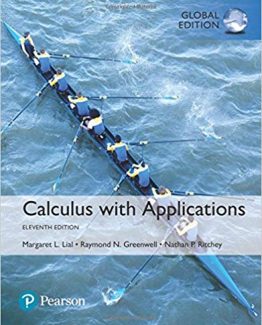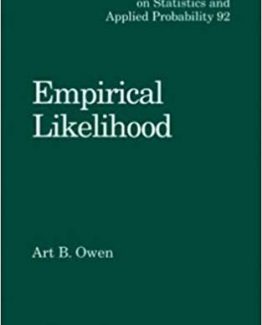Precalculus: A Prelude to Calculus 3rd Edition by Sheldon Axler, ISBN-13: 978-1119443339
[PDF eBook eTextbook]
- Publisher: Wiley; 3rd edition (August 21, 2017)
- Language: English
- 576 pages
- ISBN-10: 1119443334
- ISBN-13: 978-1119443339
Sheldon Axler’s Precalculus: A Prelude to Calculus, 3rd Edition focuses only on topics that students actually need to succeed in calculus. This book is geared towards courses with intermediate algebra prerequisites and it does not assume that students remember any trigonometry. It covers topics such as inverse functions, logarithms, half-life and exponential growth, area, e, the exponential function, the natural logarithm and trigonometry.
Table of Contents:
About the Author v
Preface to the Instructor xv
Acknowledgments xxi
Preface to the Student xxiii
Chapter 0 The Real Numbers 1
0.1 The Real Line 2
Construction of the Real Line 2
Is Every Real Number Rational? 3
Problems 5
0.2 Algebra of the Real Numbers 6
Commutativity and Associativity 6
The Order of Algebraic Operations 7
The Distributive Property 8
Additive Inverses and Subtraction 9
Multiplicative Inverses and the Algebra of Fractions 10
Symbolic Calculators 13
Exercises, Problems, and Worked-out Solutions 15
0.3 Inequalities, Intervals, and Absolute Value 20
Positive and Negative Numbers 20
Inequalities 21
Intervals 23
Absolute Value 25
Exercises, Problems, and Worked-out Solutions 29
Chapter Summary and Chapter Review Questions 35
Chapter 1 Functions and Their Graphs 37
1.1 Functions 38
Definition and Examples 38
The Domain of a Function 41
The Range of a Function 42
Functions via Tables 44
Exercises, Problems, and Worked-out Solutions 45
1.2 The Coordinate Plane and Graphs 50
The Coordinate Plane 50
The Graph of a Function 52
Determining the Domain and Range from a Graph 54
Which Sets are Graphs of Functions? 56
Exercises, Problems, and Worked-out Solutions 56
1.3 Function Transformations and Graphs 63
Vertical Transformations: Shifting, Stretching, and Flipping 63
Horizontal Transformations: Shifting, Stretching, Flipping 66
Combinations of Vertical Function Transformations 68
Even Functions 71
Odd Functions 72
Exercises, Problems, and Worked-out Solutions 73
1.4 Composition of Functions 81
Combining Two Functions 81
Definition of Composition 82
Decomposing Functions 85
Composing More than Two Functions 85
Function Transformations as Compositions 86
Exercises, Problems, and Worked-out Solutions 88
1.5 Inverse Functions 93
The Inverse Problem 93
One-to-one Functions 94
The Definition of an Inverse Function 95
The Domain and Range of an Inverse Function 97
The Composition of a Function and Its Inverse 98
Comments About Notation 99
Exercises, Problems, and Worked-out Solutions 101
1.6 A Graphical Approach to Inverse Functions 106
The Graph of an Inverse Function 106
Graphical Interpretation of One-to-One 107
Increasing and Decreasing Functions 108
Inverse Functions via Tables 110
Exercises, Problems, and Worked-out Solutions 111
Chapter Summary and Chapter Review Questions 115
Chapter 2 Linear, Quadratic, Polynomial, and Rational Functions 119
2.1 Lines and Linear Functions 120
Slope 120
The Equation of a Line 121
Parallel Lines 125
Perpendicular Lines 126
Exercises, Problems, and Worked-out Solutions 128
2.2 Quadratic Functions and Conics 135
Completing the Square and the Quadratic Formula 135
Parabolas and Quadratic Functions 138
Circles 140
Ellipses 142
Hyperbolas 144
Exercises, Problems, and Worked-out Solutions 146
2.3 Exponents 157
Positive Integer Exponents 157
Defining x0 159
Negative Integer Exponents 160
Roots 161
Rational Exponents 164
Properties of Exponents 165
Exercises, Problems, and Worked-out Solutions 166∂
2.4 Polynomials 174
The Degree of a Polynomial 174
The Algebra of Polynomials 175
Zeros and Factorization of Polynomials 177
The Behavior of a Polynomial Near ±∞ 179
Graphs of Polynomials 181
Exercises, Problems, and Worked-out Solutions 182
2.5 Rational Functions 187
The Algebra of Rational Functions 187
Division of Polynomials 188
The Behavior of a Rational Function Near ±∞ 191
Graphs of Rational Functions 194
Exercises, Problems, and Worked-out Solutions 195
Chapter Summary and Chapter Review Questions 201
Chapter 3 Exponential Functions, Logarithms, and e 203
3.1 Logarithms as Inverses of Exponential Functions 204
Exponential Functions 204
Logarithms Base 2 206
Logarithms with Any Base 207
Common Logarithms and the Number of Digits 208
Exercises, Problems, and Worked-out Solutions 209
3.2 The Power Rule for Logarithms 214
Logarithm of a Power 214
Radioactive Decay and Half-Life 215
Change of Base 217
Exercises, Problems, and Worked-out Solutions 219
3.3 The Product and Quotient Rules for Logarithms 223
Logarithm of a Product 223
Logarithm of a Quotient 224
Earthquakes and the Richter Scale 225
Sound Intensity and Decibels 226
Star Brightness and Apparent Magnitude 227
Exercises, Problems, and Worked-out Solutions 228
3.4 Exponential Growth 235
Functions with Exponential Growth 236
Population Growth 239
Compound Interest 241
Exercises, Problems, and Worked-out Solutions 245
3.5 e and the Natural Logarithm 250
Estimating Area Using Rectangles 250
Defining e 252
Defining the Natural Logarithm 254
Properties of the Exponential Function and Natural Logarithm 255
Exercises, Problems, and Worked-out Solutions 256
3.6 Approximations and Area with e and ln 262
Approximation of the Natural Logarithm 262
Approximations with the Exponential Function 263
An Area Formula 265
Exercises, Problems, and Worked-out Solutions 267
3.7 Exponential Growth Revisited 270
Continuously Compounded Interest 270
Continuous Growth Rates 271
Doubling Your Money 272
Exercises, Problems, and Worked-out Solutions 274
Chapter Summary and Chapter Review Questions 278
Chapter 4 Trigonometric Functions 281
4.1 The Unit Circle 282
The Equation of the Unit Circle 282
Angles in the Unit Circle 283
Negative Angles 284
Angles Greater than 360◦ 286
Length of a Circular Arc 287
Special Points on the Unit Circle 287
Exercises, Problems, and Worked-out Solutions 289
4.2 Radians 295
A Natural Unit of Measurement for Angles 295
The Radius Corresponding to an Angle 298
Length of a Circular Arc 300
Area of a Slice 301
Special Points on the Unit Circle 301
Exercises, Problems, and Worked-out Solutions 302
4.3 Cosine and Sine 307
Definition of Cosine and Sine 307
The Signs of Cosine and Sine 309
The Key Equation Connecting Cosine and Sine 310
The Graphs of Cosine and Sine 311
Exercises, Problems, and Worked-out Solutions 313
4.4 More Trigonometric Functions 317
Definition of Tangent 317
The Sign of Tangent 318
Connections Among Cosine, Sine, and Tangent 319
The Graph of Tangent 320
Three More Trigonometric Functions 321
Exercises, Problems, and Worked-out Solutions 322
4.5 Trigonometry in Right Triangles 327
Trigonometric Functions via Right Triangles 327
Two Sides of a Right Triangle 328
One Side and One Angle of a Right Triangle 329
Exercises, Problems, and Worked-out Solutions 331
4.6 Trigonometric Identities 336
The Relationship Among Cosine, Sine, and Tangent 336
Trigonometric Identities for the Negative of an Angle 338
Trigonometric Identities with π/2 339
Trigonometric Identities Involving a Multiple of π 341
Exercises, Problems, and Worked-out Solutions 343
Chapter Summary and Chapter Review Questions 348
Chapter 5 Trigonometric Algebra and Geometry 351
5.1 Inverse Trigonometric Functions 352
The Arccosine Function 352
The Arcsine Function 354
The Arctangent Function 357
Exercises, Problems, and Worked-out Solutions 359
5.2 Inverse Trigonometric Identities 365
Composition of Trigonometric Functions and Their Inverses 365
More Inverse Functions 366
More Compositions with Inverse Trigonometric Functions 367
The Arccosine, Arcsine, and Arctangent of −t 369
Arccosine Plus Arcsine 370
Exercises, Problems, and Worked-out Solutions 371
5.3 Using Trigonometry to Compute Area 375
The Area of a Triangle via Trigonometry 375
Ambiguous Angles 376
The Area of a Parallelogram via Trigonometry 377
The Area of a Polygon 378
Trigonometric Approximations 380
Exercises, Problems, and Worked-out Solutions 383
5.4 The Law of Sines and the Law of Cosines 388
The Law of Sines 388
The Law of Cosines 390
When to Use Which Law 393
Exercises, Problems, and Worked-out Solutions 395
5.5 Double-Angle and Half-Angle Formulas 402
The Cosine of 2θ 402
The Sine of 2θ 403
The Tangent of 2θ 404
The Cosine and Sine of θ/2 404
The Tangent of θ/2 406
Exercises, Problems, and Worked-out Solutions 407
5.6 Addition and Subtraction Formulas 414
The Cosine of a Sum and Difference 414
The Sine of a Sum and Difference 416
The Tangent of a Sum and Difference 417
Products of Trigonometric Functions 418
Exercises, Problems, and Worked-out Solutions 418
5.7 Transformations of Trigonometric Functions 423
Amplitude 423
Period 425
Phase Shift 426
Fitting Transformations of Trigonometric Functions to Data 429
Exercises, Problems, and Worked-out Solutions 430
Chapter Summary and Chapter Review Questions 437
Chapter 6 Sequences, Series, and Limits 439
6.1 Sequences 440
Introduction to Sequences 440
Arithmetic Sequences 442
Geometric Sequences 443
Recursively Defined Sequences 445
Exercises, Problems, and Worked-out Solutions 448
6.2 Series 453
Sums of Sequences 453
Arithmetic Series 453
Geometric Series 455
Summation Notation 457
Pascal’s Triangle 459
The Binomial Theorem 462
Exercises, Problems, and Worked-out Solutions 465
6.3 Limits 470
Introduction to Limits 470
Infinite Series 473
Decimals as Infinite Series 476
Special Infinite Series 477
Exercises, Problems, and Worked-out Solutions 479
Chapter Summary and Chapter Review Questions 482
Chapter 7 Polar Coordinates, Vectors, and Complex Numbers 483
7.1 Polar Coordinates 484
Defining Polar Coordinates 484
Converting from Polar to Rectangular Coordinates 485
Converting from Rectangular to Polar Coordinates 485
Graphs of Polar Equations 488
Exercises, Problems, and Worked-out Solutions 491
7.2 Vectors 494
An Algebraic and Geometric Introduction to Vectors 494
Vector Addition 496
Vector Subtraction 498
Scalar Multiplication 500
The Dot Product 500
Exercises, Problems, and Worked-out Solutions 503
7.3 Complex Numbers 506
The Complex Number System 506
Arithmetic with Complex Numbers 507
Complex Conjugates and Division of Complex Numbers 508
Zeros and Factorization of Polynomials, Revisited 511
Exercises, Problems, and Worked-out Solutions 514
7.4 The Complex Plane 518
Complex Numbers as Points in the Plane 518
Geometric Interpretation of Complex Multiplication and Division 519
De Moivre’s Theorem 522
Finding Complex Roots 523
Exercises, Problems, and Worked-out Solutions 524
Chapter Summary and Chapter Review Questions 526
Appendix: Area 527
Circumference 527
Squares, Rectangles, and Parallelograms 528
Triangles and Trapezoids 529
Stretching 531
Circles and Ellipses 531
Exercises, Problems, and Worked-out Solutions 534
Photo Credits 543
Index 545
Colophon: Notes on Typesetting 551
Sheldon Axler was valedictorian of his high school in Miami, Florida. He received his AB from Princeton University with highest honors, followed by a PhD in Mathematics from the University of California at Berkeley.
As a Moore Instructor at MIT, Axler received a university-wide teaching award. He was then an assistant professor, associate professor, and professor in the Mathematics Department at Michigan State University, where he received the first J. Sutherland Frame Teaching Award and the Distinguished Faculty Award.
Axler came to San Francisco State University as Chair of the Mathematics Department in 1997. In 2002, he became Dean of the College of Science & Engineering at SF State, a position he held until returning full-time to mathematics in 2015.
Axler received the Lester R. Ford Award for expository writing from the Mathematical Association of America in 1996. In addition to publishing numerous research papers, Axler is the author of five mathematics textbooks, ranging from freshman to graduate level. His book Linear Algebra Done Right has been adopted as a textbook at over 300 universities.
Axler has served as Editor-in-Chief of the Mathematical Intelligencer and as Associate Editor of the American Mathematical Monthly. He has been a member of the Council of the American Mathematical Society and a member of the Board of Trustees of the Mathematical Sciences Research Institute. Axler currently serves on the editorial board of Springer’s series Undergraduate Texts in Mathematics, Graduate Texts in Mathematics, and Universitext.
The American Mathematical Society honored Axler by selecting him as a member of its inaugural group of Fellows in 2013.
What makes us different?
• Instant Download
• Always Competitive Pricing
• 100% Privacy
• FREE Sample Available
• 24-7 LIVE Customer Support





